Can’t sleep? Don’t count sheep, talk to the shepherd.” I read on a church billboard in Taradale suburb. Or pop up to the Mission cellar door for a very generous sampling of seven wines and a free engraved glass for $5.00 (£2.50) instead, which is what we did, enough to ensure a good night’s sleep for us.
The Mission nestles in the Taradale Hills equidistant between Hastings and Napier and the first few handfuls of vines were brought to this region by some of the same French Marist Missionaries whose fellow brothers set up the Pompallier Mission and printing press in Russell back in 1838, a couple of years before the ‘new country’ became a British Colony.
Their first venture into viticulture was established along the nobly named Ngaruroro River where they engaged in a balanced farm with cattle and fruit trees as well as the fledgling vines, but they had expansion on their minds. So they bought some land on the sandy lowlands in Meeanee not far from the coast, set up a vineyard focussing on sacramental wines and table wines and started selling them commercially in 1870 under the expert guidance of New Zealand’s primary pioneering winemaker, Brother Cyprian Huchet whose father was a vigneron in the Loire Valley in France.
Then they learned the ‘Noah Lesson’ when a flood wrecked their vineyard in 1897. So true to NZ unstop ability they divided their colonial style two storeyed home up into eleven pieces and moved it up to higher land in 1909 where it still stands in 800 acres overlooking the sloping hills of vines.
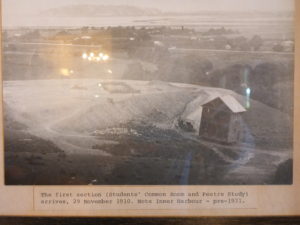
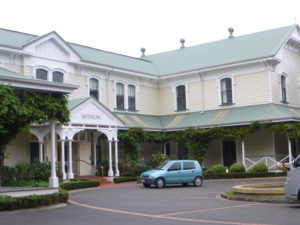
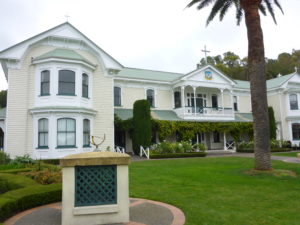
Mary served us our samples as she juggled us with another couple. She has spent a number of years travelling the world, working where she can and is off to Bali soon. She told us about her Uncle and Aunt who love cruising like us. They had their first boat sink beneath them but now have another to enjoy.
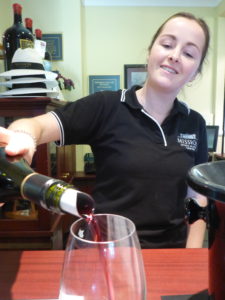
There are five ranges of wines for sampling, the most expensive being a five year old Chardonnay and a same aged Syrah in the range named after Brother Huchet. Their flavour is still a mystery to us. Our samples came from the Jewelstone and Reserve Wine Ranges and the oldest was a 2013 Cabernet Franc. To finish, a ‘Late Harvest’ as they name dessert wines, from the Estate Wine range was surprisingly unsweet and very pleasant. We came away with two bottles of Sauvignon Blanc, from 2015 and 2017 and the names of our intended dinner guests in our minds.
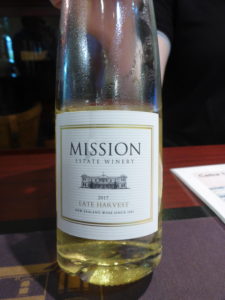
Return to Rotorua
We awoke to the sound of Tui calling to eachother across the campsite and managed to stow an almost dry tent. The timing was perfect, as we sat in the empty communal kitchen munching toast the heavens opened once again but all our gear was now inside our little Tui.
Flying low across numerous hill ranges including Ahimanawa and Waipunga and through little towns and villages such as Te Haroto, Tarawera, Pohukura and Rangitaiki, all easier to type than say, we were in the company of many double loggers and camper vans travelling for work and play along State Highway 5.
Logging was big business here and the scraped hillsides were in places re-planted and I wondered if the more mature re-growth areas were natural or part of some commercial plan or maybe even an attempt to restore native forest, who knows.
Tui skipped sideways across her half, or so it felt, as the winds buffeted her in our descent to Lake Taupo. Always a windy lake from what we’ve seen both now and on our previous visit with our family last April during Cyclone Cook’s reign.
The contours of the hills were replaced with flat plains and intensive dairy farms. Hundreds of cows standing shoulder to shoulder on shadeless paddocks with hardly enough room to lower their heads and graze. As Rob said if they have a few trees where they are grazing cows and sheep will choose the shade to rest in away from the sun, so how uncomfortable they must be when there is no shade. To these ‘farmers’ cows are industrial objects.
One estate had literally ‘set aside’ a tiny area in each field alongside the fence and popped a handful of trees in it. Was this some new requirement we wondered to which they were paying lip service.
Then we were leaving the flat plains and smaller farms and fields with trees and streams spread randomly over the lightly grazed land farmed by families still living in the farmhouses predominated the area.
It was lunchtime and The Pig and Whistle in Rotorua provided us with very generous portions of fish, chips and salad and a welcome pint. You would never have known it was a pub except for the Green Canopy near the entrance with the familiar ‘English’ pub name written on it. Built with 37 tons of reinforcing steel inside 18 inch concrete walls faced with red brick this purpose built police station was clearly designed to have strength to match its purpose, except the designers forget to draw in any cells! Opened in 1940 the features include some nice Maori and art deco touches and it is, even today, an impressive construct. It has been a pub for 25 years, almost as long as it was a cop shop.
Well-nourished we went off to explore Rotorua for the first time. When we were here before we camped at Cosy Cottage Holiday Camp on ground warmed by the subterranean thermal activity and engrossed ourselves in Maori culture for the night at the Mitai Experience, we never went into the town.
The rain was holding off so we wandered the pretty lakeshore with its mudpools and sulphur aroma giving way to cooler water and birdlife. Mokoia Island is now a bird sanctuary and has a delightful legend I will tell you another time. It lay a few miles into the Lake, a gently sloping, almost round forested mound just beckoning us for a visit, another time maybe. We were keen to find lodgings for the night as the weather was still threatening to be stormy.
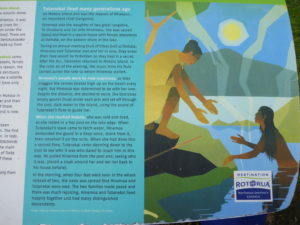
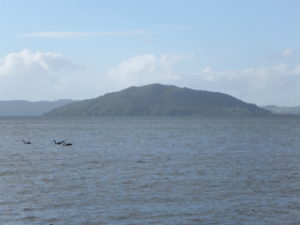
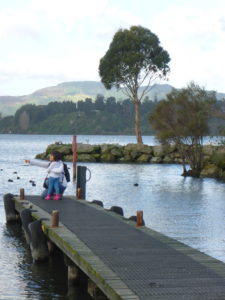
On our way back to the centre and the I-Site we passed a magnificent building with vertical and horizontal brown painted ‘beams’ on the cream walls. It was barricaded and although it looked in perfect condition it had been deemed to not reach earthquake standards and the Rotorua Museum had been closed for two years. The staff at the I-Site had no idea what was happening or where the exhibits were and there seemed to be no alternative location. For such as prominent area as this, with its long and fascinating history to be without a museum to tell its story seemed very strange to us.
We queued at this very popular I-Site to book a Duck Tour onto three of the eighteen lakes the next day at 2.00pm and then went to settle into our cabin at the town centre Top 10. The last time we were here, at Cosy Cottage, Rob and I languished in one of two hot water pools set in an enclosed area with a roof and lots of tropical plants but here the pools were outside and with the air felling quite chilly we gave them a miss.
Tuhoto’s Prophecy comes true as Mt Tarawera Awakens
Tuhoto was a Maori priest and in his one hundred years he had seen many changes come to his people and they displeased him. The ways of his ancestors were giving way to a strange modernity.
Not far from his village is Mt Tarawera (1111metres to its erupted height) which was thought to be extinct in Tuhoto’s time. On one side of the partially collapsed rim a hot water spring flowed down the outside of the mount and over many years the minerals in the water formed terraces of rounded pools. The higher ones were white and further down the valley they were pink. The water in the pools at the top were naturally the hottest and the water cooled as it flowed down through the lower terraces.
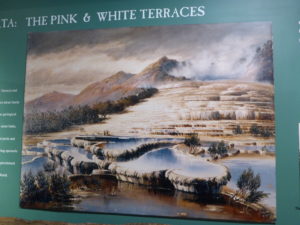
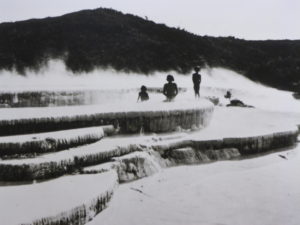
Maoris loved to relax in the pools and when the first Pakeha arrived and settled in the area both Maori and the settlers were keen to exploit the commercial potential of what became known as the Eighth Natural Wonder of The World. A small town with two hotels grew up around Tuhoto’s village known as Te Wairoa and hordes of visitors made the difficult and long journey from Europe to swim in these beautiful pools.
Some Maoris, including a woman named Sophie became much respected guides taking their curious clients across the lake in row boats to scramble through the native forest to the glistening spectacles. One day in 1886 a phantom Waka or war canoe was seen on the lake in a time when there were few left in New Zealand and none in this area. The guide reported it to Tuhoto who took it as a prophecy that immense destruction was on its way.
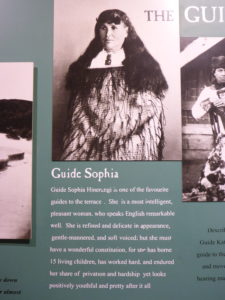
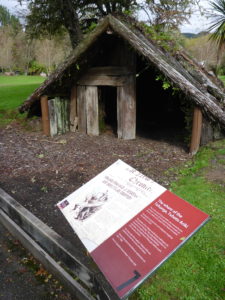
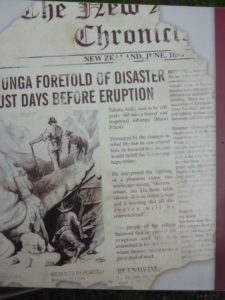
No one wanted to believe him but two weeks later the sleeping giant erupted with such violence that Lake Tarawera itself exploded sending millions of tons of mud down the nearby valleys burying numerous villages to a depth of many metres. Te Wairoa received one and a half to two metres of mud but in the valley below the terraces Maori villages were buried much deeper and no one survived.
In Te Wairoa the Maoris thought Tuhoto had actually caused the eruption with his prophecy and from being a much respected priest before, his people were so disgusted they left him entombed in his one roomed whare. Not forever though. He was brought out and died in a sanatorium later that year.
At the time it was thought the terraces were destroyed under the volcanic debris but in the last few weeks scientists and archaeologists have unearthed part of them and found them to be in good shape. Whether they could ever return to their pre-eruption beauty and be fed by the same spring seems very unlikely.
Oddly enough Reginald and Violet Smith bought the land just as Naples and the surrounding area were raised to the ground by the 1931 earthquake I described earlier. Their intention was to farm it and maybe they did but they also started excavating their buried village. One day ‘Vi’ was on a picnic down by the pretty stream you see in the pictures. She was idly tickling the ground when her fingers felt a stone carving that turned out to be part of a Pataka, a stone store house which when lined with fern leaves would be the storage for kumara and potatoes.
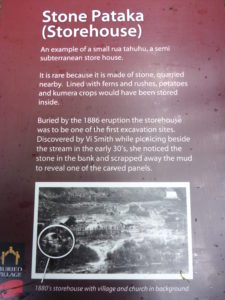
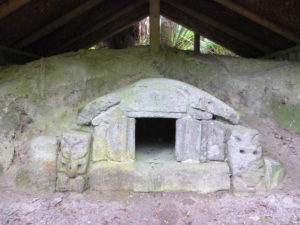
They must have loved their home and it is a pretty place. Also if you look across the stream you can make out about five tall straight trees. They are kauri, possibly planted by ‘Vi’ and Reg in an area where they don’t usually grow.
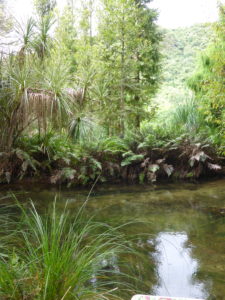
Another botanical phenomenon are the sawn off trunks in another picture. ‘Why a picture of tree stumps?’ you might well ask. Well they were originally a fence made with poplar posts bordering the track that led up to one of the hotels. After the volcanic eruption rich mud buried them leaving just a few inches exposed at the tops. Loving the moist fertile soil the posts started to grow into trees and over the next 126 years around forty of them grew to over forty metres. Sadly one fell and realising the others were unstable they had to be felled too. Given the right conditions there’s no stopping nature.
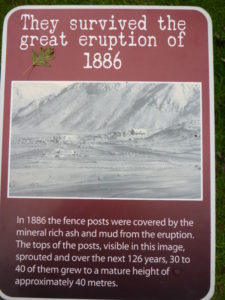
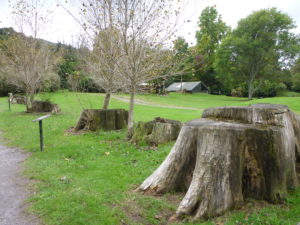
And what of poor young Edwin Bainbridge a visitor from the UK, who had lost both his brother and sister before him, and fell victim to a self-fulfilling prophecy of his own death. Killed by a wooden beam as he tried to escape from the Rotomohana Hotel in the village to safety in Sophie’s whare.

On a lighter note I cannot count the number of times contemporaries of my sewing machine have been referred to as ‘old’ and ‘historic’. This one was found after the eruption so it was placed in the fork of a small tree in what became the car park so the owner could reclaim it. Whether or not the eruption claimed the owner is not known but there it stayed as the tree grew to maturity. Locals were so fond of the tale that when the tree had to be felled they gave it a place as a museum exhibit.
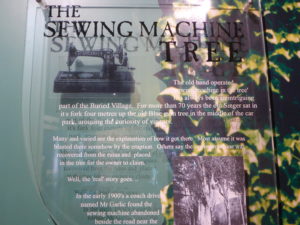
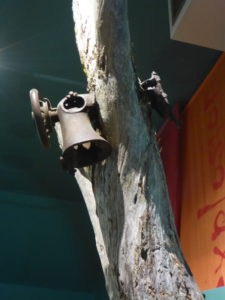
Just as we were leaving this enchanting place we spied one of the guides, Bridget, in the restaurant having her lunch. We had met her on our arrival and I didn’t think she’d mind if I asked her if the kauris were natural or introduced. You know the answer, they were introduced, but then she said that if we turned right out of the car park up the road instead of back to Rotorua and followed the road to the Tarawera Landing we should park up and walk to the left through a wire mesh gate and find the Maori cave paintings that were sunk under the lake water after the eruption but revealed once more in 1904 when the water level fell.
There was no mention of these paintings elsewhere and no signs at the lake edge. So we parked Tui and followed her instructions. Climbing down some slippery steps, infront of us was a massive rock overhang and the pictures you see in the photo, originally executed in ochre and possibly re-touched for posterity. There were the wakas again, complete with oarsmen warriors. What a find thanks to Bridget.


We walked a little further into a well-kept clearing surrounded by native bush, collected some sweet chestnuts from the rain saturated ground and could almost hear echoes of the Maori ceremony underway with its loud singing and dancing. A feast cooking in the hangi oven, children joining in the dancing till they dropped into a comforting lap, women chatting together around crackling and vibrant fires and young men and women from different iwi meeting and getting to know eathother, all under the gaze of the brooding mountain.
In a Duck to Water with Nick
The last time we took a Duck to water was in Liverpool Dockland with youngest son Jonty. It rattled worryingly and we feared for its integrity but we thought it wouldn’t be a long swim to the harbour wall if the worst happened.
The last time we came to Rotorua we immersed ourselves and our tent, almost literally, in the geothermal activity of the area and the Maori culture. So this time we focussed on four of the eighteen beautiful lakes. Back home Liverpool is very near the Lake District in Cumbria just as Rotorua nestles close by its lakes here.
“I need to tell you Nick that the last time we were on a Duck in Liverpool Docks it sank two weeks later and one on the Thames caught fire!” But Nick’s Duck was a different ball game entirely. It looked like new and was in fine condition, easily passing all its safety requirements on a regular basis. Maybe a Trigger’s Broom of the amphibious vehicle world, all of its parts replaced numerous times over the years.
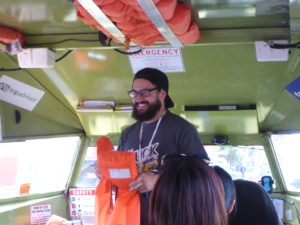
Nick was one of those typical guides full with warmth, humour and knowledge. As we sped past the forest of Californian Redwoods, Whakarewarewa Forest that grow twice as fast in the moist atmosphere here as they do in dry California he told us jokes and stories, some true others not so and played appropriate music.
The changeable weather had us fearing we’d have rain and poor visibility but we were very lucky as we could see the summit rim of Mt Tarawera for the first time. But I am diving ahead. Our first lake, Okareka has numerous very expensive ($1-2 million) homes around it plus, and Nick brought us to a respectful stop, on the other side of a little rise of land we could see the brown roofs of a lodge. For a minimum of three nights we could go and stay there at $7000 a night and “cheers” glasses with the likes of Tom Cruise! Maybe not but the lodge has been 60% full since it opened years ago.
We turned a gentle circle and returned to shore, stopped, dripping on hard ground while Nick dashed around checking her underneath for weeds and stowaways, clunked over to gears and wheels from propeller and rudder and trundled off to Lake Tarawera (Burnt Spear). Nick lives just up the hill from the rock paintings we had ‘discovered’ and spends his free time fishing on the lake, so he was coming home.
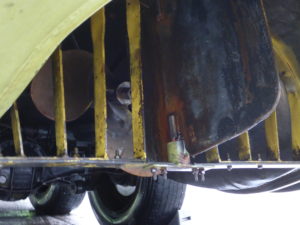

We were so fortunate travelling at this time of year because everywhere had only a few visitors in what would be heaving sites in the summer. With the Mt in view ahead of us we paused for a moment to watch a pair of endangered little black New Zealand Dabchicks nearby. We drove far enough into the lake to see the full summit of the Mt and then returned for complimentary hot and cold drinks at the café. There is a peaceful atmosphere on and around the lakes so I can quite see why the Maoris make some of them Tapu or sacred, weaving ancient legends into their waters.
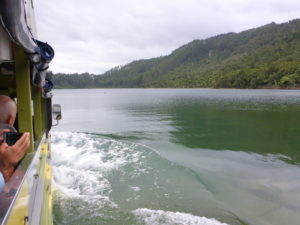
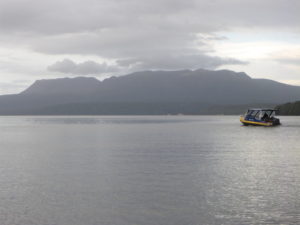
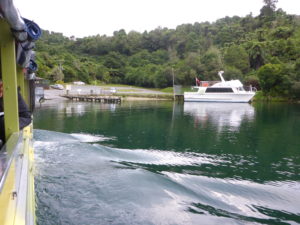
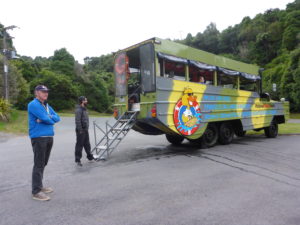
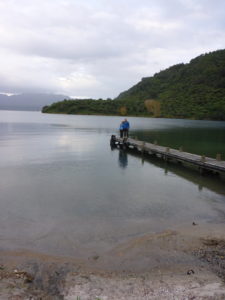
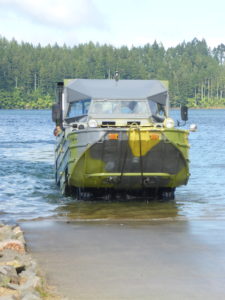
Lake Tikitapu or Blue Lake because the sky reflects from the silica on its rocky bottom has a sacred brother, Lake Rotokakahi or Green Lake is sacred and no-one is allowed to move onto the water. Heavy fines ($1000) and a lifetime of bad luck are in store for the trespasser! There is a car park on the ridge separating the two lakes from which one can see both different coloured lakes at the same time.
Once upon a time there was an extremely beautiful Maori princess who led a privileged life with loyal servants and everyone loved her. She did however have one flaw and that was carelessness. As part of her status she would wear a sacred amulet around her neck. One day while she was swimming/washing in the lake she lost this ornament and so the lake was named after it. Tiki-image, tapu-sacred.
Around the lake is a buoyed swimming lane for use in the warmer months, and across one side are little floating islands of grass made of plastic bottles tied together to try and improve the organic balance of the water. A nice use of re-cycled bottles.
There is one holiday camp on the 5.5km lake shore and we decided that was where we would spend the night with the hope we could walk the circuit in the morning. Our settler style ensuite cabin was booked previously at the I-site so to finish the perfect day we had a drink sitting in the wood-panelled lounge of Prince’s Gate Hotel, built in the pretty colonial style in 1897, while the Brothers at the Mission in Napier were recovering from their flood and Queen Victoria was coming to the end of her long reign, just to contextualize a little.
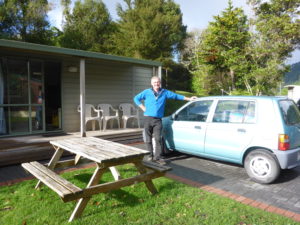
The photo of Rob in the native forest ahead of me tells the story of our walk better than I can. The path is well worn and enjoyed all year round and for some deserved refreshment, just down from our camp at the end of the walk an Airstream silver bullet camper coffee shop sells good coffee and snacks. We supped from our ‘to go’ mugs as we watched ‘our’ Duck arrive and give us nice photo opportunities before we set off on the road to Tauranga to care for Luca for five days.
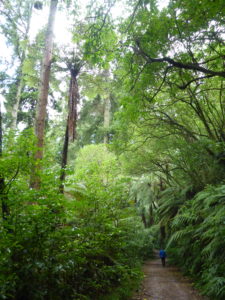
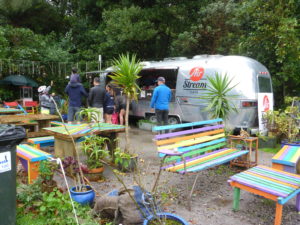
To Tauranga in ‘Tui’ – The Little Car that Can
It took only one hour to exchange the lovely Lakes of Rotorua for the long sandy beach of The Bay of Plenty and in particular the Palm Springs area of Tauranga.
Our friends Andrea and Mark left on their five day excursion the next day and Rob took to his bed feeling drained. So we had a blissfully relaxing day, me working on blogs, Luca doing his best to distract me and Rob letting Mother Nature nurse him back together while he slept.
“Luca how can I type if you walk across the keyboard!” “Miaow” and later “Please stop chewing the (top left corner of the) computer Luca it’s still 20 minutes to your breakfast time!” “Miaow”.
The Beach Bunch
We were enjoying a walk along the beach in perfect warm weather when we came across a man standing by his beach buggy parked on the sand facing away from the ocean with a metal reel secured to the flat bed of his buggy. The sunlight caught the green line that disappeared down the beach from the reel into the waves. He was effectively long line fishing from the beach. We started chatting and I asked him how he got the tackle out to sea. “With a torpedo,” he replied. The battery powered torpedo will take the line nearly a kilometre offshore and hold it there while an unwary snapper would come along and take a bite.
While we were chatting a pickup truck came down the beach and dumped the filleted skeletons of more snapper for the gulls to pick over, not that there was much left on them. It all seemed rather sad and knowing that ¾ of NZ’s native species of fish are now endangered I wondered how much longer the snapper species would survive.
‘Our guy’ had spent his summer holidays with his parents in a bach nearby, leaving behind their Hamilton home for a few weeks each year, long before there were any houses on the other side of the track behind the beach. When he grew up he bought what used to be the doctor’s house and was just enjoying a freedom he had practised all his life. Old habits die hard.
Ahead in the distance was a little raised headland beyond the development we were staying in, that sparked our curiosity and beside it the Maketu estuary. It was a little too far away to walk to, or further than we felt inclined to walk to anyway, so we decided to explore the area the next day.
A few bachs, reflecting various levels of affluence of their owners from luxury to converted containers, bordered the road up the headland, but then they ended and were replaced by a mixture of fields and woodland. A rough track continued to the right and we were advised on a sign that if we wanted access to the beach we must put $5 in the honesty box. So we did but of course with no receipt could not prove we had. I was only a little worried by this fact but I did mention it to a local resident on the beach. We chatted while watching two seals languishing in the water just off the beach. He explained that the Arawa Headland was owned by a Maori lady and he helped her by doing regular checks and keeping the loo clean.
We met such nice people on beaches.
By dint of ‘Messenger’ on Rob’s phone we made contact with our young friend Richard who is the youngest son of Rob’s friend of many years, Paul back in Oakham. Richard and his lady, Mia met while travelling and coincidentally Mia is from Leicester, not twenty miles from where he grew up, small world. They were both working briefly in Auckland and successfully finding a time when we could meet before we moved in geographically opposite directions was quite a feat, but we did on the Sunday before we left the area two days later.
They were sitting in the sun outside the I-Site in Thames and we lunched at an archetypal NZ Hotel before strolling a short distance down the path alongside the wide, silty estuary. Cook found the estuary shallow and anchored Endeavour in the centre of the Firth in 6 fathoms or 12 metres, 9 miles from the town he named Thames. He also named the river he found at the head of the firth with Dr Solander, Mr Banks and Tupia while exploring in a ship’s launch, ‘The Thames’ as the flood tide was as strong as on the London Thames and the vista similar, however now the Maori name ‘Waihou River’ prevails.
We said our farewells, got into our respective borrowed cars and sped back to feed Luca and start to gather together our few things including a bone dry tent, wondering when we would use it again.
In the evening of the next day we shared our stories with Mark and Andrea over supper and the next morning I relaxed in the last bath I would have for a while.
Our farewells said and a promise to let Andrea and Mark know when we planned to leave, Tui turned northwards and we noticed the first hints of autumn colours now more defined than when we had arrived. The Karangahake Gorge went down on my revisit list as somewhere to hire bikes and soak up the rugged beauty while exercising at some later date. Down once again onto the Hauraki Plains across the bottom of the Firth of Thames, big Jersey and mixed herds in a clearly prosperous farming area of cleared, drained land, dykes and canals.
Then we turned onto the SH1 and travelling a now familiar route returned to Zoonie.
On the Leaving of New Zealand
Preparations are now well underway for Zoonie to leave this welcoming country after 18 months. Intermingled with form filling have been lots more lovely time with friends, some of whom will sail out with us and some who will remain either because they are resident or because the boat work is not yet complete.
A couple of days ago we celebrated Rob’s 60th Birthday. While we were away Naylene prepared an invitation and pinned it up in the marina office inviting along all cruisers, so we had no idea how many to expect. On the morning walking around the area various folk had said to us they would be coming. We had guessed on about 30 and as it turned out 27 came.
Rob spent the morning making delicious desserts including lemon cheesecake, fresh fruit pavlova and fruit salad and it’s just as well we tasted them at the preparation stage because they went like a flash on the evening and we were left with just the crumbs! Sweet toothed bunch us cruisers. So what did I do in the way of preparation you might well ask? I made the green and potato salads, sliced the French Sticks and motivated the birthday boy.
Rob gave one of his from the heart speeches thanking everyone for all their support and friendship and Sharron (Marina Manager) by way of a birthday gift made the two of us and Zoonie honorary founder members of the Black Ball Yacht Club which was a kind and unexpected touch.
In case you are interested in putting faces to our friends’ names I will list them from the photo after the cake. The first picture is obvious and in the next one Rob is talking to Judy with the white hair who is married to Steve from Code Blue and they are American. Also the couple in that pic are Sarah and Phil from Serenity of Swanwick on the Hamble in Hampshire. From left to right in the next pic are Sabine and blue eyed Hannes, our Austrian friends from Cayenne and Eric from Scoots and he has just returned from the USA after the same operation as Rob had. The two handsome, mature guys in the next pic left to right are Tony, (Gail’s husband both from the USA) and much mentioned Merv from here in Whangarei.
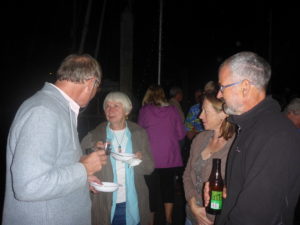
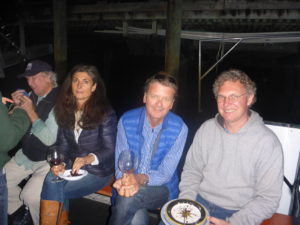
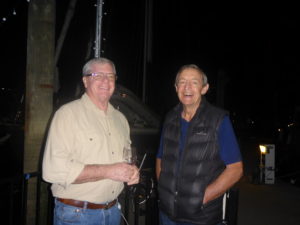
Next along are Jaap and Renee our Netherland friends from De Ware Jacob, they have just returned to their re-decked yacht from Rotterdam where Renee underwent brain surgery and is recovering well. The next photo is self-explanatory and then there is Robyn from Mintaka and me. After that Laurie and Chuck are a couple and Ian and his wife (not present) own an Oyster named Oyster Reach and are planning a similar route to us. Gail is with Rob in the next pic then Jeannie (Merv’s Queen Bee) and Rob and the remaining pics subjects I have already mentioned.
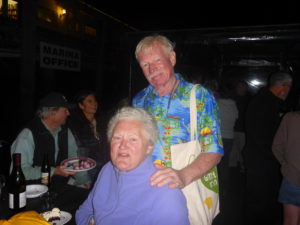
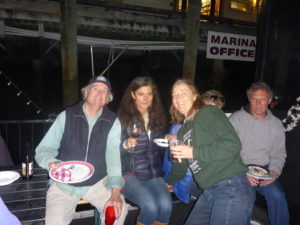
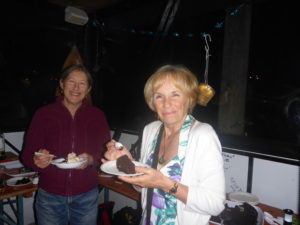

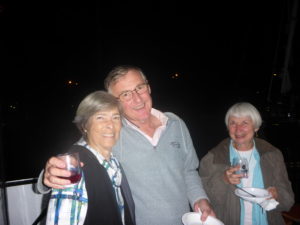
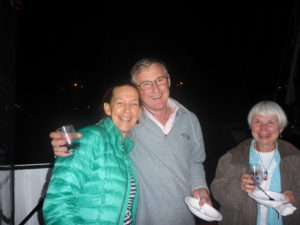
On Monday we will send our Inward Document (6 pages) to Fiji with an intended departure date of 15th May and arrival date 10 days later, its 1143 miles to Suva. So we’ll see how that pans out eh!
